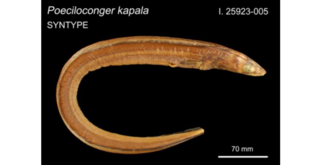
The Opiliones are an order of arachnids colloquially known as harvestmen, harvesters, harvest spiders, or daddy longlegs. As of April 2017, over 6,650 species of harvestmen have been discovered worldwide, although the total number of extant species may exceed 10,000. The order Opiliones includes five suborders: Cyphophthalmi, Eupnoi, Dyspnoi, Laniatores, and Tetrophthalmi, which were named in 2014.

Anaspides is a genus of freshwater crustaceans in the family Anaspidesidae. The genus was first described in 1894 by George Malcolm Thomson. The genus was originally placed in the family, Anaspididae by Thomson, but this genus name was preoccupied by the insect genus, Anaspis Geoffroy, 1762, and therefore, in 2017, the family was renamed Anaspidesidae by Shane Ahyong and Miguel A. Alonso-Zarazaga.

Dyspnoi is a suborder of harvestmen, currently comprising 43 extant genera and 356 extant species, although more species are expected to be described in the future. The eight families are currently grouped into three superfamilies: the Acropsopilionoidea, Ischyropsalidioidea, and Troguloidea.

The Triaenonychidae are a family of harvestmen with about 120 genera and more than 440 described species.
The Synthetonychiidae are a small family of harvestman with a handful of species in a single genus. They are endemic to New Zealand.
The Cokendolpher cave harvestman, Texella cokendolpheri, is a species of cave-living harvestman native to Bexar County, Texas. The original common name, the Robber Baron Cave harvestman, stemmed from the cave which the harvestman inhabits. The scientific name and the current common name honor the prominent arachnologist, James Cokendolpher, who identified the species. T. cokendolpheri is one of twenty-eight species within the North American harvestman genus Texella. The first formal description of the harvestman took place in 1992 and the species’ listing under the Endangered Species Act followed eight years later. Current threats to the species include habitat loss and interactions with invasive fire ants.
Exit Cave, Tasmania is a large multi entrance cave near Ida bay in southern Tasmania.

Gaius villosus is a species of spider in the family Idiopidae found in Western Australia in a variety of different habitats.

Pantopsalis cheliferoides is a species of Neopilionid harvestmen. This species was originally described by William Colenso and is endemic to New Zealand.

Pantopsalis listeri is a species of harvestman in the family Neopilionidae.
Arbanitis wayorum is a species of armoured trap-door spider in the family Idiopidae, and is endemic to New South Wales.
Arbanitis maculosus is a species of armoured trap-door spider in the family Idiopidae, and is endemic to New South Wales.
Arbanitis montanus is a species of armoured trap-door spider in the family Idiopidae, and is endemic to New South Wales.
Arbanitis melancholicus is a species of armoured trap-door spider in the family Idiopidae, and is endemic to New South Wales.

Bellorchestia marmorata is a marine amphipod in the Talitridae family.

Ariosoma kapala is an eel in the family Congridae. It was first described in 1990 by Peter H. J. Castle as Poeciloconger kapala. The holotype was collected by the New South Wales Fisheries Research Vessel Kapala on April 11, 1985, during a bottom trawl at a depth of 46-64 m. The species was named for the FRV Kapala. In 1998, Shieh-Chieh Shen moved the species to the genus Ariosoma.

Forsteropsalis photophaga, also known as the glow-worm hunter, is a species of long-legged harvestman in the family Neopilionidae. This species is endemic to New Zealand, found in North Island caves in the vicinity of Waitomo. The name "photophaga" comes from their habit of feeding on the luminescent larvae, pupae, and adults of the New Zealand glow-worm Arachnocampa luminosa.
Natatolana sinuosa is a species of crustacean in the family Cirolanidae, and was first described by Stephen John Keable in 2006. The species epithet, sinuosa, describes the "sinuate posterior margins of the coxae".









